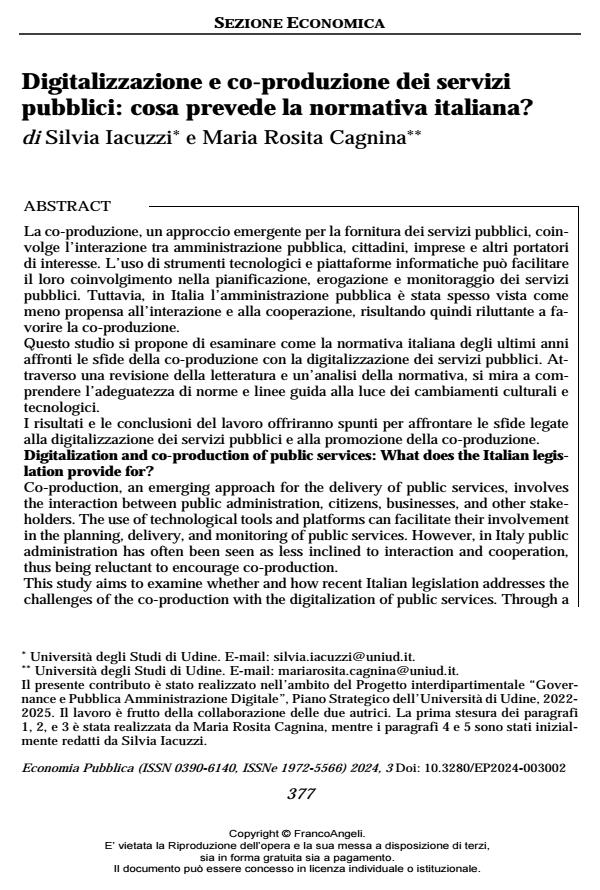Digitalizzazione e co-produzione dei servizi pubblici: cosa prevede la normativa italiana?
Titolo Rivista ECONOMIA PUBBLICA
Autori/Curatori Silvia Iacuzzi, Maria Rosita Cagnina
Anno di pubblicazione 2024 Fascicolo 2024/3
Lingua Italiano Numero pagine 30 P. 377-406 Dimensione file 173 KB
DOI 10.3280/EP2024-003002
Il DOI è il codice a barre della proprietà intellettuale: per saperne di più
clicca qui
Qui sotto puoi vedere in anteprima la prima pagina di questo articolo.
Se questo articolo ti interessa, lo puoi acquistare (e scaricare in formato pdf) seguendo le facili indicazioni per acquistare il download credit. Acquista Download Credits per scaricare questo Articolo in formato PDF

FrancoAngeli è membro della Publishers International Linking Association, Inc (PILA)associazione indipendente e non profit per facilitare (attraverso i servizi tecnologici implementati da CrossRef.org) l’accesso degli studiosi ai contenuti digitali nelle pubblicazioni professionali e scientifiche
La co-produzione, un approccio emergente per la fornitura dei servizi pubblici, coinvolge l’interazione tra amministrazione pubblica, cittadini, imprese e altri portatori di interesse. L’uso di strumenti tecnologici e piattaforme informatiche può facilitare il loro coinvolgimento nella pianificazione, erogazione e monitoraggio dei servizi pubblici. Tuttavia, in Italia l’amministrazione pubblica è stata spesso vista come meno propensa all’interazione e alla cooperazione, risultando quindi riluttante a favorire la co-produzione. Questo studio si propone di esaminare come la normativa italiana degli ultimi anni affronti le sfide della co-produzione con la digitalizzazione dei servizi pubblici. Attraverso una revisione della letteratura e un’analisi della normativa, si mira a comprendere l’adeguatezza di norme e linee guida alla luce dei cambiamenti culturali e tecnologici. I risultati e le conclusioni del lavoro offriranno spunti per affrontare le sfide legate alla digitalizzazione dei servizi pubblici e alla promozione della co-produzione. Digitalization and co-production of public services: What does the Italian legislation provide for? Co-production, an emerging approach for the delivery of public services, involves the interaction between public administration, citizens, businesses, and other stakeholders. The use of technological tools and platforms can facilitate their involvement in the planning, delivery, and monitoring of public services. However, in Italy public administration has often been seen as less inclined to interaction and cooperation, thus being reluctant to encourage co-production. This study aims to examine whether and how recent Italian legislation addresses the challenges of the co-production with the digitalization of public services. Through a literature review and an analysis of the regulatory framework, we aim to understand the adequacy of norms and guidelines in light of cultural and technological changes. The results and conclusions of the research will provide insights to address the challenges related to the digitalization of public services and the fostering of coproduction.
Parole chiave:ICT, pubblica amministrazione, co-produzione, servizi pubblici.
Jel codes:L32, M00, O32
Silvia Iacuzzi, Maria Rosita Cagnina, Digitalizzazione e co-produzione dei servizi pubblici: cosa prevede la normativa italiana? in "ECONOMIA PUBBLICA " 3/2024, pp 377-406, DOI: 10.3280/EP2024-003002